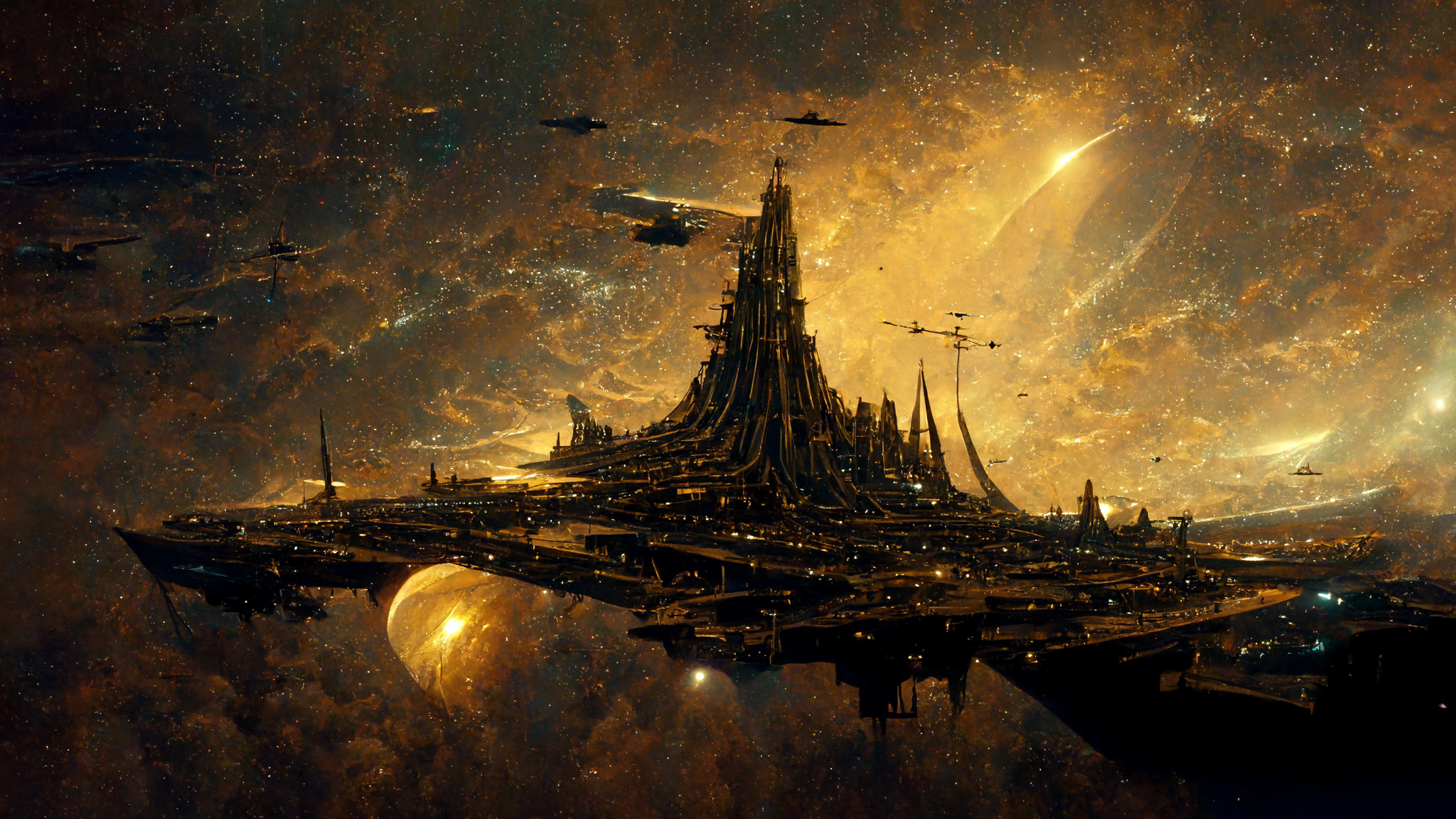Sidebar
Table of Contents
Shurista
Shurista is one of fourteen “original” Senti Flotillas, dating back over half a million years to the end of the last war of the Senti. It was named for General Shurista Eskydas who, in mythology, along with Diplomat Sentisura1) were two of the first leaders to play a role in the imprisonment of Rustybe Eskydas, and the dismissal of her ship to hyperspace with no return. It was diplomatically pulled into the Yamatai Star Empire in YE 44 by Ranga Havard and currently governed by Khelas Nascen.
History
The history of Shurista is long and complex, having been one of the original Flotillas left at the end of the Skydas War.
Since then, Shurista has made its way across the Kagami galaxy, salvaging, growing, and building, until it came to rest in the Western Lonely Expanse near core Yamatai. Typically, Shurista would have moved on, however, stable trade prompted them to stay, and when offered the choice of leaving or joining the Yamatai Star Empire, Khelas Nascen declared that “I am not subjecting my children to a revolving door of laws and zealous tourists. Nor to Aether fire or the knowledge of abandoning our kin and claim to the wide spaces between the stars that you do not use. Too much at risk in the long term. Perhaps Yamatai will collapse before the end of my time. Or it learns to endure as we do. We have been out here since the Skydas War, travelling. We made our home in this gap.”
The implication is believed to be that the Shuristans were in the stars before Yamatai, and will likely be there long after.
Not long after, it was recommended for Shurista to assimilate a then under construction Zodiac Class Station Capricorn to allow a Yamataian sector of the Flotilla separate of the main superstructure and act as a mobile fleet depot and shipyard. }
Description
Shurista is a mobile megastructure, by loose technicality. Measuring approximately 9300 kilometers in diameter, and approximately 150 kilometers in thickness, it appears as a slowly spinning aggregate disc, with a mass of approximately 7.346*1019 metric tons 2)
This disc is made up of millions of starship hulls welded together, with large structures made of burial steel and scrap metal, or large domes of starship window glass, showing large agricultural developments both inside and out of atmosphere. Dozens or hundreds of ships can often be seen flying cargo to various portions of the Flotilla, maneuvering across the outside.
The outer edge of Shurista is primarily dominated by spaceports shipyards, and breaker yards, utilizing the orbital velocity spin of the edge of Shurista to neutralize the gravitational forces involved. This allows vessels to use less fuel to dock, rather than fighting gravity.
Normally, a space port would be fairly self explanatory, especially in deep space. Whether by gravity based docking web, tractor beams, or creative maneuvering, spaceports and their docks are always busy places, with ships coming and going, environmental protection personnel inspecting vessels to prevent the spread of invasive species and alien diseases, medical and technical personnel swarming over ships and docks of a thousand different forms and more worlds found in the Senti's travels. Shipbreaker yards and shipyards are sort of an interchangable term, with many ships eventually being welded to the hull and hollowed out to form alcloves that build apartments, parks, etc.
Mobility
Shurista, like all Senti Flotillas, is capable of FTL and basic maneuvering in deep space, though cannot generate the acceleration to escape or safely enter a solar gravitational sphere, and due to its diameter, cannot safely orbit a planet due to tidal forces, and is thus required to maintain a minimum safe distance from any star, though can be often found in deep interstellar space.
Its jump signature is best described as reality boiling, due to millions of synchronized jump drives producing overlapping warp bubbles that allow the vessel to travel as one pocket of real space, without disturbing the constant fleet activity surrounding it.
Transportation
To get to Shurista is half the challenge. As a mobile megastructure, it can easily move, jumping away from incoming craft or sensor sweeps and being small enough to be extremely difficult to detect in the empty light years of space of the Lonely Expanse.
Though the Yamatai Star Empire is unsure of Shurista's location at any given time, there are two ways to find it. Yamataian military vessels on official Star Army of Yamatai business can easily lock onto and follow beacons provided by making contact with Zodiac Star Forteress Capricorn integrated into the hull. Otherwise, Shuristan Senti crew are almost always taught songs by an oral tradition called Gift of Song. This is sung to new pilot-ship crews during their maiden flight as a beacon to guide them home. Due to the fact that basic flight systems are a requirement for Shuristan adulthood, these beacons are running day and night, by the thousands. Singing these into the static of deep subspace channels will usually cause the Flotilla to start “singing back,” where many of the transmitters across the surface will return the signal with their own countersignal, often a similar or the same piece of music.
Certain pieces of music have been known to summon the Flotilla itself without acting as a beacon. It is not, at this time, known what those are.
Most Shuristans don't stray far from their ships or apartment, as the aggregate disk is almost three thousand kilometers in radius. However, it does have a robust disc-wide transit system and multiple crossplanar flights daily, some ships even offering flights inside of the megastructure.
People
Shuristans are known for courage and instinctive violence of action.
Like all Senti, the Shuristan culture demands greatest long term good with minimum harm. However, this courtesy does not extend to pirates, invaders, or any who would deny a thorough claim on mining rights and salvage. Attempting to attack Shuristan scrappers or miners often ends with their beam cutters being turned from mining equipment to weapons with seamless and ruthless efficiency.
Generally speaking, Shuristans handle fear by asserting dominance quickly and striking down resistance. Their anger, however, carries far more follow through and planning, and an angered Shuristan is a force of nature backed by hundreds of thousands of years of ancestors' will, experience, and strength.
Demographics
At last estimation, Shurista held a standing, self proclaimed population of 2.75 billion Tsulrati, 99.95% of which self identify as the “Followers of Sentisura”, commonly called the Senti culture. This includes the main population and the multiple thousands of ships whose origin name is Eshurista.
Approximately 3% of the population has immigrated within the last 1-2 generations, either from planets or other Flotillas.
Of these Senti, approximately 8% are of “Skydasir” ethnicity, featuring iridescent eyes and skin that shows a similar iridescence when wet.
4% of the population of Shurista is of other ethnicities.
Approximately 0.1% of Shurista's permanent population is not of Senti descent.
Characters
Here's an automatic list of all characters currently aboard (Including those in the Yamataian Sector).
Shurista Main
| Character Name | Occupation | Gender | Species |
|---|---|---|---|
| Khelas of Nascen | Xenopolitician, Governor | Female | Senti |
| Dusali Kharras | Medical Anthropologist and advisor | Female | Senti |
Economics and Currency
Shurista's economy is based around trade and education, primarily, with a currency based on water volume aboard the Flotilla.
The physical currency is comprised of a collection of weighted rings that denote a value in liters of fresh water, usually minted from chromium or iron. Due to the sheer volume of water, denotations are often in the tens or hundreds of liters, with a universal basic income that pays individuals based on the use of waste systems, and trades water chits for goods and services, from power, food, and rent, to luxury or custom craft items.
Their economic structure is based on the idea that no labor is unskilled labor, and companies and cooperatives are required to pay based on demonstrated skill of the worker, rather than education or experience. This allows highly talented people to find gainful employment that matches their skillset, and encourages the persuit of careers in fields the person is skilled in, rather than having people stuck in jobs they are overqualified for or poorly suited for on skillset.
Moreover, persuit of knowledge is a highly valued skill, with librarians and educators being among the highest paying jobs on the Flotilla, next to spaceport hands, pilots, and spacecraft technicians.
Emergency Management Plan
Shurista has two main methods of emergency management.
- In the event of exterior threats, such as debris storms, magnetar or pulsar storms, or outside attack, relocation is the primary option, with combat capable mining and salvage vessels used to buy time, if applicable. Shurista is uniquely capable of a maximum FTL speed of 5 LY/hr.
- In the event of internal issues such as massive hull failures, water contamination, or disease outbreak, see following plan and resources.
Shurista has the following in place.
- 80% of Shurista's fleet is classified as evacuation capable ships, 30% of which belong to the Civil Service.
- 0 H Bunkers and other Bunkers.
- The modular and piecemeal hull of Shurista allows sections to be sealed off and isolated from the main structure with little modification due to lessons learned from Turassiel.
- National Police and Fire can be found in any zone marked with the Civil Service logos, including public libraries, any police or fire station, and all governing offices and buildings. The logo will usually be a pictogram of the government service imprinted on a vertically divided semiround shield.
Shurista also has the following inventory
- All vessels bearing the Shuristan flag and rated for spaceworthiness are required to be able to sustain the recommended crew size in tricentennial personnel indefinitely, often offering a 75%+ surplus of fresh meat, vegetables, and goods. However, manufacturing and processing capabilities are not required.
- All civilian population centers have food and supply manufacturing and storage, with dry goods produced and stored at surplus.
- Civilian logistics caches can be found in the geometric center of civil service buildings, and behind access panels below any park statue. These caches are small and often refilled due to unsecured public access.
Please note that many of these practices have been in place for centuries, and are reported for YEMA compliance only.
Evacuation plan
When the Gift of Song ends, the Shuristan councils acting have commandeered the Shuristan communications network and will put out an all hands call. Any civilians owning space suits are recommended to don these at this time.
Threat type and condition will then be broadcast sector or flotilla wide, where the affected areas are to be evacuated by directing civilian personnel into the public transit system for screening and transport to the docks. From there, evacuation vessels will cycle through the dockyard, picking up as many as possible before ferrying civilians away. Destinations will be determined en route.
Civil service teams will go door to door to seek out stragglers, directing any remaining to the docks and providing medical aid as necessary.
RP Opportunities
Talk about what characters can experience and do here. Got recommendations? Ideas? Help fuel some RP.
Local Rumors
Put plot hooks and local rumors in this section.
- Missing persons reports increased in area of Capricorn Module
- Crop blight in domes near Capricorn Module
- Degrading burial steel near agricultural domes affected by blights
- Grand Library research
Assets
These destinations represent the core of Shurista's cultural and technological significance.
The Shuristan Grand Library
Shurista's shrine to the Goddess of Information, the Grand Library exists at the core of the superstructure, hidden behind millions of tons of steel and glass, lit by starlight amplifying gems and artificial starlight from the Reactor Tree. Within its halls and shelves one can find texts in hundreds of thousands of archaic languages representing not only the sum of Senti knowledge and technology from before the Skydas War, but also extant texts, artifacts, and servers from the tens of thousands of dead and dying peoples the Senti have found in their travels.
This includes archaeotechnology examples, theorums, mathematical models, and religious texts. Each worldsection is prefaced with the race's physiology, their status as of Shurista's last visit, and the reasons found, if applicable, for its fall.
Each world's records include base genetic samples and sequences for some of the most successful and unique species of each world, from plants and wild animals, to now extinct sapients.
Tens of thousands of Shuristans live comfortably in its halls, devoting their existence to the preservation of this knowledge.
The Reactor Tree
Standing in the center of Shurista's rotational mass, and growing from the core of the supercarrier of that war is the Reactor Tree, where millions of reactor cores are fed, fuelled, and kept running by thousands of loving technicians. Its superstructure provides thirty percent of the power needs of the Flotilla, and more than 90% of its vertical structural integrity. These millions of reactors form an abstract tree like structure more than a hundred kilometers in height, and several kilometers wide at its narrowest point. Operational extant examples of all known jump drives and starship reactors can be found in its superstructure, with hyperspace taps and fusion bottles being the most common.
The Biological Preservation Domes
Like all agricultural domes on Shurista, these are made up of millions of tons of reformed starship window glass embedded in burial steel and other metals to form transparent, starlit domes lit from within in a simulated day and night cycle.
The difference, however, is in their purpose, as a nature preserve of billions of distinct species of plant life from across the galaxy, often from worlds suffering ecological collapse. These plants provide food, oxygen, and rare xenobiology research opportunities, alongside marking the Shuristan commitment to protecting and preserving life. These domes also house thousands of species of wildlife, often from similar worlds.
The Domes are often used as a form of research lab to replicate the conditions a species would have lived under before sequencing and cloning can begin, normally with the goal of expanding the Grand Library's capabilities and knowledge.
Zodiac Star Fortress Capricorn
Integration into Yamataian society began in YE 44 with the integration of the partially completed Zodiac Fortess Capricorn into the superstructure below the Grand Library and Reactor Tree. All Yamataian personnel have direct access to the Grand Library and the fortress serves as a Yamataian sector of Shurista. This sector falls under the normal laws of the Yamatai Star Empire and is completely exempt of normal Shuristan Law, with the implication that the Shuristans expect similar treatment.
OOC Notes
Madison Harper created this article on 2022/08/13 20:14 using the namespace template.
(Put art credits here)
| Places of the SARPiverse | |
|---|---|
| Opened/Settled (YE) | Pre-History - Before YE 01 |
| Place Categories | space station, star system |
| Risk Level | moderate |
Page Tools
Terms of Service - Privacy Policy



